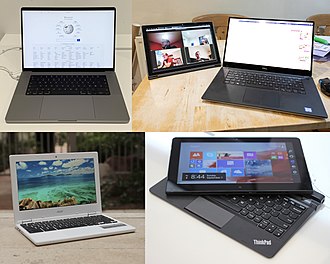
Back Skootrekenaar Afrikaans ላፕቶፕ Amharic حاسوب محمول Arabic لاب توب ARZ Ordenador portátil AST ल्यापटप AWA Notbuk Azerbaijani Ноўтбук Byelorussian Kumputer tèngtèng BEW Преносим компютър Bulgarian

A laptop computer or notebook computer, also known as a laptop or notebook, is a small, portable personal computer (PC). Laptops typically have a clamshell form factor with a flat-panel screen on the inside of the upper lid and an alphanumeric keyboard and pointing device on the inside of the lower lid.[1][2] Most of the computer's internal hardware is in the lower part, under the keyboard, although many modern laptops have a built-in webcam at the top of the screen, and some even feature a touchscreen display. In most cases, unlike tablet computers which run on mobile operating systems, laptops tend to run on desktop operating systems, which were originally developed for desktop computers.
Laptops are used in a variety of settings, such as at work (especially on business trips), in education, for playing games, web browsing, for personal multimedia, and for general home computer use. They can run on both AC power and rechargable battery packs and can be folded shut for convenient storage and transportation, making them suitable for mobile use.[3] Laptops combine many of the input/output components and capabilities of a desktop computer into a single unit, including a display screen (usually 11–17 in or 280–430 mm in diagonal size), small speakers, a keyboard, and a pointing device (namely compact ones such as touchpads or pointing sticks). Hardware specifications may vary significantly between different types, models, and price points.
The word laptop, modeled after the term desktop (as in desktop computer), refers to the fact that the computer can be practically placed on the user's lap; while the word notebook refers to most laptops sharing a form factor with paper notebooks. As of 2024[update], in American English, the terms laptop and notebook are used interchangeably;[4] in other dialects of English, one or the other may be preferred.[5] The term notebook originally referred to a type of portable computer that was smaller and lighter than mainstream laptops of the time, but has since come to mean the same thing and no longer refers to any specific size.
Design elements, form factors, and construction can also vary significantly between models depending on the intended use. Examples of specialized models of laptops include 2-in-1 laptops, with keyboards that either be detached or pivoted out of view from the display (often marketed having a "laptop mode"), and rugged laptops, for use in construction or military applications. Portable computers, which later developed into modern laptops, were originally considered to be a small niche market, mostly for specialized field applications, such as in the military, for accountants, or travelling sales representatives. As portable computers evolved into modern laptops, they became widely used for a variety of purposes.[6]
- ^ "Introducing Pixel Slate – Pixel Slate Help". support.google.com. Retrieved 21 September 2022.
- ^ "Microsoft Surface Pro 8 review: the best of both worlds". The Verge. 5 October 2021. Retrieved 21 September 2022.
- ^ Beal, Vangie (September 1996). "What is Laptop Computer? Webopedia Definition". Webopedia. Retrieved 1 December 2022.
- ^ "Laptop vs desktop: which should you buy?". TechRadar. Retrieved 1 August 2021.
- ^ Cite error: The named reference
Buzzlewas invoked but never defined (see the help page). - ^ "U.S. Commercial Channel Computing Device Sales Set to End 2013 with Double-Digit Growth, According to NPD". NPD Group. Archived from the original on 9 August 2019. Retrieved 23 September 2014.